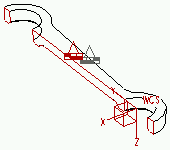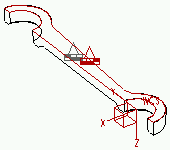Taking Advantage of Planar Symmetry
Symmetry allows you to analyze only a portion of the geometry. This has obvious benefits for solution time and resource requirements, but can also help eliminate rigid body motion. In addition to geometry, the properties, loads and constraints on your model must be symmetric.
• Constraints—For planar or reflective symmetry, constrain all degrees of freedom that permit deformation across the plane of symmetry. The following example illustrates how a model can be approximated with a one-quarter section using planar symmetry:
Full Model
a
b
Dx, Ry and Rz are fixed in a, and Dz, Rx and Ry are fixed in b. Note that solid elements do not have rotational degrees of freedom, so it is not necessary to constrain Rx, Ry and Rz in this case
• Constraints in Thermal—Thermal models require symmetry conditions, but these already exist by default. No constraint in Thermal implies that the boundary is a perfect insulator (heat will not transfer across the plane of symmetry).
• Loads—In symmetry models, loading must be symmetric also. In some cases, you must reduce the load magnitudes by the same amount as the geometry. For example, when analyzing a half section, you must halve some loads as well. In general, you must scale total loads (
point,
curve, and surface total loads,
total loads at a point,
total bearing loads at a point,
bearing loads, and
total heat loads). Loads that are a function of area (
pressure,
heat load per unit,
force per unit area) or volume (
centrifugal,
gravity,
volumetric heat load) do not need to be scaled.
• Properties—In general, only isotropic material properties should be used with symmetry unless the material orientations of an anisotropic material are, in fact, symmetric.
• Modal Analysis—It is important to realize that symmetry in
modal analyses will only compute the symmetric modes. In general, this means that you should not use symmetry for this analysis type, or for any other types that access modal results (
buckling,
dynamic time,
frequency,
random, and
shock).



